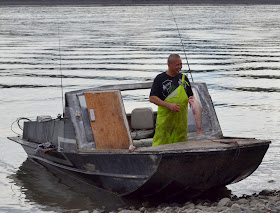Dawson City is a
designated National Historic Site and rightly so. A visit to this city takes you back in time
to the Klondike days of the gold rush and the life that was all part of that. Many of the buildings have been restored or
refurbished and offer a realistic and colourful display of the past.
 |
| Downtown Dawson City, Yukon |
There was nothing here
previous to the gold strike in 1896 but when that became public information in
July 1897, Dawson became a city almost overnight. 6.000 people arrived before winter came with
thousands more to follow which started the gold rush of 1898. Dawson City soon had a population of
30,000 people. The current population is 2,000.
 |
| Perma frost results |
These buildings were built
in 1901 and originally a hotel, photography studio and a hardware store. They’ve been left in their natural state to demonstrate
the progressive effects of having heated buildings on permafrost ground. Permafrost damage rates the second most
destructive only to fire.
 |
| Miner's tribute Dawson City River Walk |
We spent some time at the
Dawson City Museum which is in a beautifully restored old administration
building. It had some very interesting
displays plus we watched an award winning “City of Gold” film narrated by
Pierre Berton in their theatre.
 |
| Klondike Spirit on Yukon River |
The Klondike Spirit is
the only paddle wheeler operating in the Yukon.
It began in 2007 and offers historically narrated tours with
dinner. Most of the river boats of the
past were sternwheelers and although both were powered by steam engines, those
paddles were at the rear or stern of the boat.
 |
| View from the Dome |
The Dome is the place to
visit to see the spectacular view of Dawson City and the Yukon River below. Our
visit was during some seasonal wildfires in Alaska and smoke along with the clouds
may have been slightly distracting, but it was a great view.
 |
| Yukon River from the Dome |
As is still done today,
the first group of 150 visitors came up to the Dome to watch the midnight sun
at the summer solstice June 21, 1899. To
their disappointment, the sun set one half hour before midnight and rose two
hours later. The Dome still remains a
popular spot to celebrate long summer nights.
 |
| Diamond Tooth Gerties |
One of the busiest places
in town was Diamond Tooth Gerties. This
is a casino and did have the modern day slot machines in there but the best
part and what brought us here was the live show in the old fashioned hall with “Gertie”
a great singer and entertainer and her showgirls, who kept the energy
high.
 |
| Robert Service Cabin |
Robert Service left this
rented cabin in 1912 but it soon became the Yukon’s number one tourist
attraction, it symbolizes the legacy of the Klondike Gold Rush.
Jack London lived in Dawson City in 1897/98
to prospect gold but due to scurvy had to leave. He later became a famous author with his many
books based on life in Alaska.
Pierre Berton, a famous Canadian historian and author lived in Dawson City until he was 12 years old then went back and worked
in Klondike mining camps during his university years. Each of their homes are historical sites in
Dawson City, Yukon.
 |
| Dredge #4 |
A dredge is a floating
sluice plant used to dig for gold. We
went for a tour of the largest gold digging machine of its kind in North
America, out at Bonanza Creek, where the famous gold rush began. The Dawson City area mined 88% of all gold
mined in Canada and Dredge #4 recovered 8 metric tons of that gold over 46 year
period.
 |
| Bonanza Creek Tailings |
The sight that greets us
just outside of Dawson City is the tailings that are the result of the early
mining days. They are the waste that is
left after the gold has gone through the many screens and sluices. Not the least bit attractive, but they are
part of the story of the Klondike gold rush days.
We are on our way up the
Dempster Highway when we leave Dawson City,
click here, so much more to see.









































